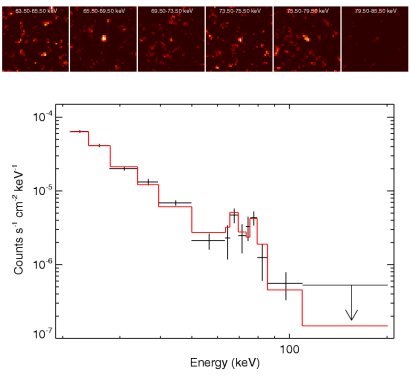Gamma Ray Emission from Cassiopeia A
29 September 2006
Supernovae and their remnants are the main galactic nucleosynthesis sites. Few radioactive isotopes are accessible to gamma-ray astronomy for probing these stellar explosions. Among them, 44Ti is a key isotope for the investigation of the inner regions of supernovae and their young remnants.With a decay time of 86 years, 44Ti emits three gamma-ray lines at 67.9, 78.4 (from 44Sc) and 1157 keV (from 44Ca), all observable with SPI and IBIS onboard INTEGRAL. This short decay time of 44Ti makes it ideal to study young supernova remnants, which are thought to be efficient particle accelerators.
The first direct proof that this short-lived isotope is indeed produced in supernovae came in 1994 with the detection of 1157 keV (44Ca) line emission from Cassiopeia A (Iyudin, A.F. et al. [1994]). The observations were made with COMPTEL onboard the Compton Gamma-Ray Observatory (CGRO).
Cassiopeia A (Cas A) is the youngest known Galactic supernova remnant and is indeed the only one from which the line emission from 44Ti decay has yet been unambiguously detected.
IBIS/ISGRI Observations of 44Ti decay in Cas A
In an article recently published in the Astrophysical journal, Renaud et al. report new detailed observations of Cas A with the Integral Soft Gamma-Ray Imager (ISGRI) of the Imager on-Board INTEGRAL Satellite (IBIS) instrument. Compared to earlier observations, the IBIS/ISGRI observations have an improved spectral resolution and an improved significance of the detection of the hard X-ray nonthermal continuum up to 100 keV. The latter gives more stringent constraints on both the line intensities and the underlying continuum emission of the supernova remnant.
Deep observations (3.2 Ms effective exposure) with INTEGRAL IBIS/ISGRI of the Cassiopeia region allowed to detect the two low-energy 44Sc lines at 67.9 and 78.4 keV in Cas A. Besides the robustness provided by these IBIS/ISGRI spectroimaging observations, the main improvements compared to previous measurements are the clear separation of the two lines and the significant detection of the hard X-ray continuum up to 100 keV, well fitted by a single power-law. The estimate of the line flux is sensitive to that of this underlying continuum whose nature is still unknown (possibly synchrotron or nonthermal bremsstrahlung).
The 44Ti yield deduced from these observations is ~1.6×10-4 solar masses. This is consistent with the yield of between (1.4 ± 0.4) x 10-4 and (3.2 ± 0.8) x 10-4 solar masses as reported by Iyudin, A.F. et al. [1994] based on earlier COMPTEL observations. This amount of ejected 44Ti is generally thought to be unusually large in comparison with spherical explosion models, but could be explained by several effects such as asymmetries during the explosion and a high explosion energy.
Based on this firm detection of the 44Ti signature in Cas A with IBIS/ISGRI, the expected results with SPI, thanks to its fine spectral resolution should help to constrain for the first time the kinematics of the innermost layers of the supernova explosion.
Related Publications
Renaud, M. et al., "The Signature of 44Ti in Cassiopeia A Revealed by IBIS/ISGRI on INTEGRAL", ApJ Vol. 647 (2006), pages L41-L44
Iyudin, A.F. et al, "COMPTEL observations of Ti-44 gamma-ray line emission from CAS A", A&A Vol. 284 (1994), pages L1-L4


